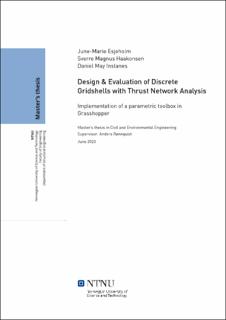| dc.contributor.advisor | Rønnquist, Anders | |
| dc.contributor.advisor | Dyvik, Steinar Hillersøy | |
| dc.contributor.advisor | Luczkowski, Marcin | |
| dc.contributor.author | Esjeholm, June-Marie | |
| dc.contributor.author | Haakonsen, Sverre Magnus | |
| dc.contributor.author | Instanes, Daniel May | |
| dc.date.accessioned | 2021-09-21T16:08:40Z | |
| dc.date.available | 2021-09-21T16:08:40Z | |
| dc.date.issued | 2020 | |
| dc.identifier | no.ntnu:inspera:56731605:34504265 | |
| dc.identifier.uri | https://hdl.handle.net/11250/2780000 | |
| dc.description.abstract | I prosjekters startfase er det ofte arkitektens visjoner som spiller førstefiolin, og de
lastbærende egenskapene er ikke nødvendigvis i fokus. Når ingeniører på et senere
tidspunkt skal verifisere byggets egenskaper risikerer en at arkitektens opprinnelige ideer
må ofres for fysikkens ufravikelige lover. En risikerer dermed et sluttresultat hvor visjon
går på akkord med funksjon.
Thrust Network Analysis er en «formfinningsmetode» introdusert av Block (2009). Opprinnelig
ble metoden utviklet for å verifisere stabiliteten til mur- og steinkonstruksjoner. Denne
oppgaven søker å evaluere nevnte metodes egnethet til bruk på «diskre gitterskall». Nye
utfordringer introduseres når egenvekt i mindre grad dominerer lastbildet, og horisontallaster
vil i større grad påvirke konstruksjonens form og funksjon.
Ved å programmere en serie komponenter som er kompatible med Grasshopper får
både arkitekter og ingeniører muligheten til å utvikle materialeffektive gitterskall, som i
hovedsak transporterer lastene gjennom membrankrefter, allerede fra designstart.
Videre introduseres en to-dimensjonal forenkling av en global stabilitetsanalyse. Gjennom
å bruke den projiserte geometrien, og krefter fra Thrust Network Analysis, kan brukeren
evaluere gitterskallets stabilitet uten å måtte etablere en komplett elementanalyse.
Resultatene fra komponentene sammenlignes så med tall fra en elementanalyse for å
kartlegge styrker og svakheter.
Oppgaven avslutter med ulike eksempelstudier. Først brukes verktøyet som en del av
en større «formfinningsprosess» hvor den globale formen først etableres ved hjelp av
de introduserte verktøyene, for så å optimaliseres ved hjelp av blant annet Galapagos.
Etter dette blir det i samarbeid med Ph.d. kandidat i arkitektur, Steinar Hillersøy Dyvik,
presentert et designforslag til en industrihall. Her brukes komponentene både til utforming
og evaluering av konstruksjonen.
Avslutningsvis vil et variert utvalg former demonstrere fleksibiliteten til komponentene.
Sammen med resten av eksempelstudiene viser denne masteroppgaven hvordan denne
måten å jobbe på kan skape konstruksjoner som er både konstruktive og meningsfulle. | |
| dc.description.abstract | During the early stages of a building project, the structural efficiency of the building is
seldom the main area of interest, and is often left for the structural engineer at a later
stage. As a consequence, the end result often suffers from compromises between the
architect’s vision and structural concerns.
Thrust network analysis is a form finding method developed by Block (2009) as a way
of evaluating the stability of masonry structures. This thesis aims to investigate the
functionality of the aforementioned method by applying it to single layer gridshells.
Which in turn introduces new challenges where self-weight no longer acts as the governing
load, and live load will consequently have a bigger impact on the design.
Using the visual programming language Grasshopper, a series of components are created
in order to implement the method in a parametric environment. This enables both
architect and engineers to explore the funicular shape of gridshells in early stage design
with real time feedback on the viability of the given form.
In addition, a proposal for a simplified global buckling analysis is presented. By using
the projected geometry and results from the Thrust Network Analysis, the user gets an
indication of the structures’ global stability without the need to establish a finite element
analysis.
After the implementation, a series of case studies are conducted. The developed components
are first tested on simple structures as a way of verifying the plausibility of the produced
results. In addition, a case study is presented where the method is used as a part of a
larger form finding procedure. Here the implemented components are used to create
the initial global geometry, before further optimisation is performed by the evolutionary
solver Galapagos.
Two design proposals for a timber gridshell hall is then developed using the components
in collaboration with the PhD candidate in architecture Steinar Hillersøy Dyvik. The
components ability to create and modify a structure, before verifying the forces are
evaluated here.
Finally, a series of arbitrary geometries are used to illustrate the flexibility of the created
solver. Together, the case studies demonstrate how the created components can be used
to create structural efficient gridshells in a conceptual design phase. | |
| dc.language | | |
| dc.publisher | NTNU | |
| dc.title | Design & Evaluation of Discrete Gridshells with Thrust Network Analysis | |
| dc.type | Master thesis | |
